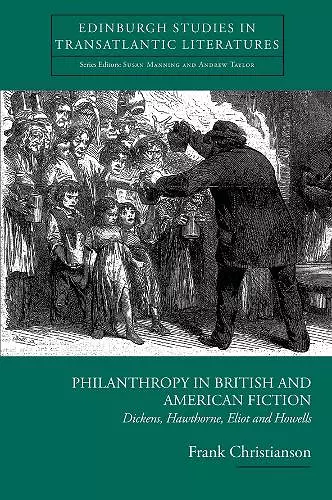Philanthropy in British and American Fiction
Dickens, Hawthorne, Eliot and Howells
Format:Hardback
Publisher:Edinburgh University Press
Published:28th Nov '07
Currently unavailable, and unfortunately no date known when it will be back

During the 19th century the U.S. and Britain came to share an economic profile unparalleled in their respective histories. This book suggests that this early high capitalism came to serve as the ground for a new kind of cosmopolitanism in the age of literary realism, and argues for the necessity of a transnational analysis based upon economic relationships of which people on both sides of the Atlantic were increasingly conscious. The nexus of this exploration of economics, aesthetics and moral philosophy is philanthropy. Pushing beyond reductive debates over the benevolent or mercenary qualities of industrial era philanthropy, the following questions are addressed: what form and function does philanthropy assume in British and American fiction respectively? What are the rhetorical components of a discourse of philanthropy and in which cultural domains did it operate? How was philanthropy practiced and represented in a period marked by self-interest and rational calculation?The author explores the relationship between philanthropy and literary realism in novels by Charles Dickens, Nathaniel Hawthorne, George Eliot, and William Dean Howells, and examines how each used the figure of philanthropy both to redefine the sentiments that informed social identity and to refashion their own aesthetic practices. The heart of this study consists of two comparative sections: the first contains chapters on contemporaries Hawthorne and Dickens; the second contains chapters on second-generation realists Eliot and Howells in order to examine the altruistic imagination at a culminating point in the history of literary realism.
Philanthropy in British and American Fiction avoids becoming simply yet another account of how nineteenth-century novelists, for all their sympathetic accounts of the poor, used their art for the consolidation of bourgeois hegemony, by making important claims about the parallels between philanthrophy and literary realism. Times Literary Supplement Christianson persuades us that the relationships among philanthropy, sentimentalism, realism, class, and professionalism are suggestive and worthy of sustained analysis. SEL - Studies in English Literature 1500-1900 Philanthropy in British and American Fiction avoids becoming simply yet another account of how nineteenth-century novelists, for all their sympathetic accounts of the poor, used their art for the consolidation of bourgeois hegemony, by making important claims about the parallels between philanthrophy and literary realism. Christianson persuades us that the relationships among philanthropy, sentimentalism, realism, class, and professionalism are suggestive and worthy of sustained analysis.
ISBN: 9780748625086
Dimensions: unknown
Weight: unknown
256 pages